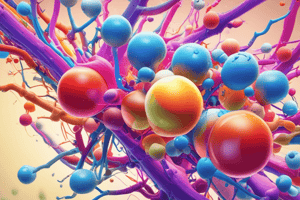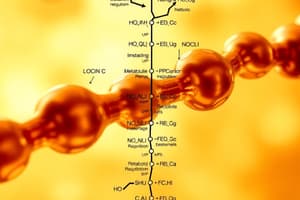Podcast
Questions and Answers
What type of reactions are involved in metabolism?
What type of reactions are involved in metabolism?
Where is excess glucose stored in the body?
Where is excess glucose stored in the body?
Which molecule provides more ATP, glucose, or triglycerides?
Which molecule provides more ATP, glucose, or triglycerides?
What happens to excess proteins in the body during starvation mode?
What happens to excess proteins in the body during starvation mode?
What can glucose intermediates be used to make in different tissues?
What can glucose intermediates be used to make in different tissues?
Glucose from complex carbohydrates is primarily used for energy storage in the liver and skeletal muscle.
Glucose from complex carbohydrates is primarily used for energy storage in the liver and skeletal muscle.
Proteins are broken down into fatty acids during protein synthesis.
Proteins are broken down into fatty acids during protein synthesis.
Glycogen is broken down into glucose for energy storage in the liver and skeletal muscle.
Glycogen is broken down into glucose for energy storage in the liver and skeletal muscle.
Triglycerides provide less ATP than glucose when broken down into glycerol and fatty acids.
Triglycerides provide less ATP than glucose when broken down into glycerol and fatty acids.
Excess proteins are directly used for energy production in the body during normal metabolic conditions.
Excess proteins are directly used for energy production in the body during normal metabolic conditions.
Triglycerides from fats can be broken down into glycerol and fatty acids for ______ storage
Triglycerides from fats can be broken down into glycerol and fatty acids for ______ storage
Proteins are broken down into amino acids for protein ______
Proteins are broken down into amino acids for protein ______
Excess glucose can be stored as ______ through an anabolic reaction in the liver and skeletal muscle
Excess glucose can be stored as ______ through an anabolic reaction in the liver and skeletal muscle
Glucose intermediates can be used to make glycerol, fatty acids, or even converted into certain amino acids in different ______ depending on the enzymes expressed
Glucose intermediates can be used to make glycerol, fatty acids, or even converted into certain amino acids in different ______ depending on the enzymes expressed
Glucose from complex carbohydrates like starch is broken down in the digestive system, absorbed into the blood, and used for cellular respiration to produce ______
Glucose from complex carbohydrates like starch is broken down in the digestive system, absorbed into the blood, and used for cellular respiration to produce ______
Match the following with their correct descriptions:
Match the following with their correct descriptions:
Match the following with their correct roles in metabolism:
Match the following with their correct roles in metabolism:
Match the following with their correct functions in the body:
Match the following with their correct functions in the body:
Match the following nutrient breakdown products with their sources:
Match the following nutrient breakdown products with their sources:
Match the following metabolic pathways with their outcomes:
Match the following metabolic pathways with their outcomes:
Flashcards are hidden until you start studying
Study Notes
- Metabolism involves catabolic reactions (breakdown of molecules) and anabolic reactions (building of molecules) in the body.
- Glucose from complex carbohydrates like starch is broken down in the digestive system, absorbed into the blood, and used for cellular respiration to produce ATP.
- Excess glucose can be stored as glycogen through an anabolic reaction in the liver and skeletal muscle.
- Triglycerides from fats can be broken down into glycerol and fatty acids for energy storage, with triglycerides providing significantly more ATP than glucose.
- Proteins are broken down into amino acids for protein synthesis, with excess proteins broken down into amino acids for energy in starvation mode.
- Glucose intermediates can be used to make glycerol, fatty acids, or even converted into certain amino acids in different tissues depending on the enzymes expressed.
Studying That Suits You
Use AI to generate personalized quizzes and flashcards to suit your learning preferences.




